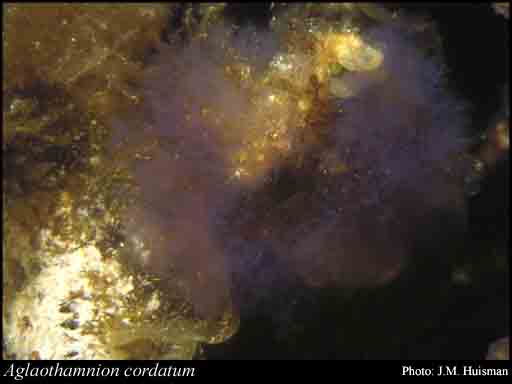- Reference
- Rech.Céram.Médit. 459 (1941)
- Conservation Code
- Not threatened
- Naturalised Status
- Native to Western Australia
- Name Status
- Current

Scientific Description
Habit and structure. Thallus generally small, to 15 mm in height, filamentous, uncorticated, alternately branched with a single lateral branch per axial cell, attached by a cluster of rhizoidal cells. Lower cells of primary axes 100–140 µm in diameter, often with L/B ± 1 but sometimes more elongate. Mid thallus cells 140–180 µm long by 50–80 µm in diameter, tapering to upper elongate cells 7–10 µm in diameter, occasionally with terminal hairs.
Reproduction. Spermatangia arising on spermatangial mother cells that arise secundly on lateral branch cells. These are borne in series of 2–3 cells that then divide longitudinally once and then transversely once, such that the resulting cluster of four cells looks cruciate when viewed from above. Each of these four cells produces a cluster of spermatangia that are clavate, approximately 7 µm long and 3–4 µm in diameter. Carpogonial branches 4-celled, arising on a supporting cell borne laterally on an axial cell. A second cell is produced opposite the supporting cell and this functions as an auxiliary mother cell. Auxiliary cells arising from both the supporting cells and the auxiliary mother cell. Gonimolobes cordate, composed entirely of carposporangia 18–19 µm in diameter. Carposporophytes with two opposite gonimolobes, in total to 350–370 µm broad. Tetrasporangia borne on distal region of lateral branch cells, ellipsoidal, 40–45 x 30–35 µm, tetrahedrally divided, generally borne singly but often with a sporangial initial proximal to the mature sporangium.
Distribution. Widely distributed in warmer waters. Australia, India, Iran, South Africa, Yemen.
Distribution
- IBRA Regions
- Carnarvon, Pilbara.
- IBRA Subregions
- Roebourne, Wooramel.
- IMCRA Regions
- Shark Bay.
- Local Government Areas (LGAs)
- Karratha, Shark Bay.